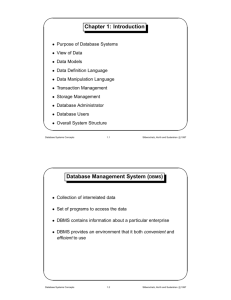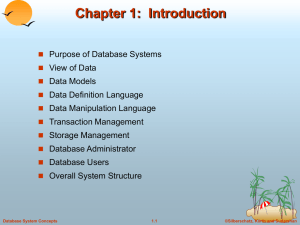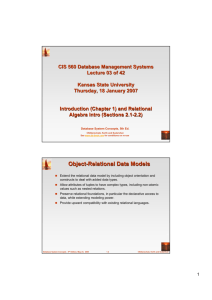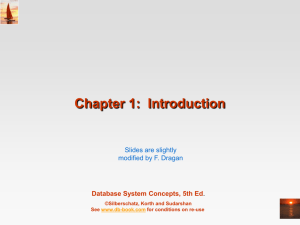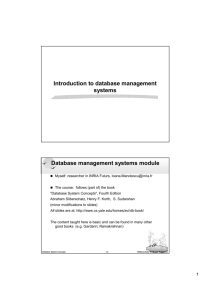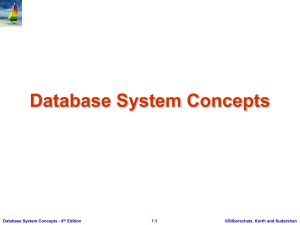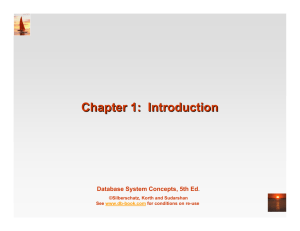Chapter 14: Query Optimization
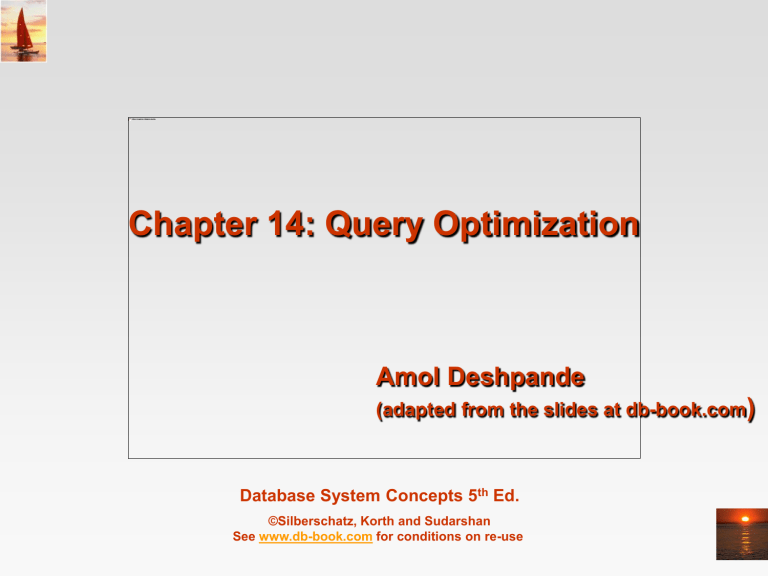
Chapter 14: Query Optimization
Amol Deshpande
(adapted from the slides at db-book.com
)
Database System Concepts 5 th Ed.
©Silberschatz, Korth and Sudarshan
See www.db-book.com
for conditions on re-use
Query Planning/Optimization
Generation of query-evaluation plans for an expression involves several steps:
1.
Generating logically equivalent expressions using equivalence rules .
2.
Annotating resultant expressions to get alternative query plans
3.
Choosing the cheapest plan based on estimated cost
The overall process is called cost based optimization.
Database System Concepts - 5 th Edition, Aug 27, 2005.
14.2
©Silberschatz, Korth and Sudarshan
Transformation of Relational Expressions
Two relational algebra expressions are said to be equivalent if on every legal database instance the two expressions generate the same set of tuples
Note: order of tuples is irrelevant
Database System Concepts - 5 th Edition, Aug 27, 2005.
14.3
©Silberschatz, Korth and Sudarshan
Equivalence Rules
1. Conjunctive selection operations can be deconstructed into a sequence of individual selections.
1
2
( E )
1
(
2
( E ))
2. Selection operations are commutative.
1
(
2
( E ))
2
(
1
( E ))
3. Only the last in a sequence of projection operations is needed, the others can be omitted.
L
1
(
L
2
( (
Ln
( E )) ))
L
1
( E )
4.
Selections can be combined with Cartesian products and theta joins.
a.
b.
(E
1
X E
2
) = E
1
1
(E
1
2
E
2
) = E
E
2
1
1
2
E
2
©Silberschatz, Korth and Sudarshan Database System Concepts - 5 th Edition, Aug 27, 2005.
14.4
Equivalence Rules (Cont.)
5. Theta-join operations (and natural joins) are commutative.
E
1
E
2
= E
2
E
1
6. (a) Natural join operations are associative:
( E
1
E
2
) E
3
= E
1
( E
2
E
3
)
(b) Theta joins are associative in the following manner:
( E
1
1
E
2
)
2
3
E
3
= E
1
1
3
( E
2
2
E
3
) where
2 involves attributes from only E
2 and E
3
.
Database System Concepts - 5 th Edition, Aug 27, 2005.
14.5
©Silberschatz, Korth and Sudarshan
Pictorial Depiction of Equivalence Rules
Database System Concepts - 5 th Edition, Aug 27, 2005.
14.6
©Silberschatz, Korth and Sudarshan
Equivalence Rules (Cont.)
7. The selection operation distributes over the theta join operation under the following two conditions:
(a) When all the attributes in
0 involve only the attributes of one of the expressions ( E
1
) being joined.
0
E
1
E
2
) = (
0
(E
1
))
E
2
(b) When
1 involves only the attributes of E
1 only the attributes of E
2
.
1
E
1
E
2
) = (
1
(E
1
))
(
and
(E
2
))
2 involves
Database System Concepts - 5 th Edition, Aug 27, 2005.
14.7
©Silberschatz, Korth and Sudarshan
Equivalence Rules (Cont.)
8. The projections operation distributes over the theta join operation as follows:
(a) if
involves only attributes from L
1
L
1
L
2
( E
1
E
2
)
(
L
1
( E
1
L
2
:
))
(
L
2
( E
2
))
(b) Consider a join E
1
E
2
.
Let L
1 and L
2 be sets of attributes from E
1 and E
2
, respectively.
Let L
3 not in be attributes of E
1
L
1
L
2
, and that are involved in join condition
, but are let L
4 not in be attributes of E
2 that are involved in join condition
, but are
L
1
L
2
.
L
1
L
2
( E
1
E
2
)
L
1
L
2
((
L
1
L
3
( E
1
))
(
L
2
L
4
( E
2
)))
©Silberschatz, Korth and Sudarshan Database System Concepts - 5 th Edition, Aug 27, 2005.
14.8
Equivalence Rules (Cont.)
9.
The set operations union and intersection are commutative
E
E
1
1
E
E
2
2
=
=
E
E
2
2
E
E
1
1
(set difference is not commutative).
10.
11.
Set union and intersection are associative.
(
( E
1
E
1
E
E
2
2
)
E
3
)
E
3
= E
1
= E
1
( E
2
( E
2
E
3
)
E
3
)
The selection operation distributes over
,
and
–.
( E
1
– E
2
) =
( E
1
) –
( E
2
) and similarly for
and
in place of –
Also:
( E
1
–
E
2
) =
( E
1
)
–
E
2 and similarly for
in place of –, but not for
12. The projection operation distributes over union
L
( E
1
E
2
) = (
L
( E
1
))
(
L
( E
2
))
©Silberschatz, Korth and Sudarshan Database System Concepts - 5 th Edition, Aug 27, 2005.
14.9
Transformation Example
Query: Find the names of all customers who have an account at some branch located in Brooklyn.
customer_name
(
branch_city = “ Brooklyn”
( branch (account depositor )))
Transformation using rule 7a.
customer_name
((
branch_city =“ Brooklyn”
( branch )) ( account depositor ))
Performing the selection as early as possible reduces the size of the relation to be joined.
Database System Concepts - 5 th Edition, Aug 27, 2005.
14.10
©Silberschatz, Korth and Sudarshan
Example with Multiple Transformations
Query: Find the names of all customers with an account at a
Brooklyn branch whose account balance is over $1000.
customer_name (
(
branch_city = “ Brooklyn” balance > 1000
( branch (account depositor )) )
Transformation using join associatively (Rule 6a):
customer_name
((
branch_city = “ Brooklyn” balance > 1000
( branch account )) depositor )
Second form provides an opportunity to apply the “perform selections early” rule, resulting in the subexpression
branch_city = “ Brooklyn”
( branch )
balance > 1000
( account )
Thus a sequence of transformations can be useful
©Silberschatz, Korth and Sudarshan Database System Concepts - 5 th Edition, Aug 27, 2005.
14.11
Multiple Transformations (Cont.)
Database System Concepts - 5 th Edition, Aug 27, 2005.
14.12
©Silberschatz, Korth and Sudarshan
Join Ordering Example
For all relations r
1, r
2, and r
3
,
( r
1 r
2
) r
3
= r
1
If r
2 r
3 is quite large and r
1
( r
2 r
3
) r
2 is small, we choose
( r
1 r
2
) r
3 so that we compute and store a smaller temporary relation.
Database System Concepts - 5 th Edition, Aug 27, 2005.
14.13
©Silberschatz, Korth and Sudarshan
Cost Estimation
Cost of each operator computer as described in Chapter 13
Need statistics of input relations
E.g. number of tuples, sizes of tuples
Inputs can be results of sub-expressions
Need to estimate statistics of expression results
To do so, we require additional statistics
E.g. number of distinct values for an attribute
More on cost estimation later
Database System Concepts - 5 th Edition, Aug 27, 2005.
14.14
©Silberschatz, Korth and Sudarshan
Statistical Information for Cost Estimation
n r
: number of tuples in a relation r.
b r
: number of blocks containing tuples of r.
l r
: size of a tuple of r.
f r
: blocking factor of r — i.e., the number of tuples of r that fit into one block.
V(A, r): number of distinct values that appear in r for attribute A; same as the size of
A
( r ).
If tuples of r are stored together physically in a file, then: b r
n r f r
Database System Concepts - 5 th Edition, Aug 27, 2005.
14.15
©Silberschatz, Korth and Sudarshan
Histograms
Histogram on attribute age of relation person
Equi-width histograms
Equi-depth histograms
Database System Concepts - 5 th Edition, Aug 27, 2005.
14.16
©Silberschatz, Korth and Sudarshan
Selection Size Estimation
A=v
( r )
n r
/ V(A,r) : number of records that will satisfy the selection
Equality condition on a key attribute: size estimate = 1
A
V
( r ) (case of
A
V
( r ) is symmetric)
Let c denote the estimated number of tuples satisfying the condition.
If min(A,r) and max(A,r) are available in catalog
c = 0 if v < min(A,r)
c = n r
.
max( v
A , min( r )
A , min( r )
A , r )
If histograms available, can refine above estimate
In absence of statistical information c is assumed to be n r
/ 2.
©Silberschatz, Korth and Sudarshan Database System Concepts - 5 th Edition, Aug 27, 2005.
14.17
Size Estimation of Complex Selections
The selectivity of a condition
i relation r satisfies
i
. is the probability that a tuple in the
If s i is the number of satisfying tuples in given by s i
/n r
.
r, the selectivity of
Conjunction:
1
2
. . .
n
i is
( r). Assuming independence, estimate of tuples in the result is: n r
s
1
s
2
.
.
.
s n n r n
Disjunction:
1
2
. . .
n
( r). Estimated number of tuples: n r
1
( 1
s n
1 r
)
( 1
s n
2 r
)
...
( 1
s n n r
)
Negation:
( r). Estimated number of tuples: n r
– size(
( r))
©Silberschatz, Korth and Sudarshan Database System Concepts - 5 th Edition, Aug 27, 2005.
14.18
Join Operation: Running Example
Running example: depositor customer
Catalog information for join examples:
n customer
= 10,000.
f customer
= 25, b customer which implies that
=10000/25 = 400.
n depositor
= 5000.
f depositor
= 50, which implies that b depositor
= 5000/50 = 100.
V(customer_name, depositor) = 2500, which implies that , on average, each customer has two accounts.
Also assume that customer_name in depositor is a foreign key on customer.
V(customer_name, customer) = 10000 (primary key!)
©Silberschatz, Korth and Sudarshan Database System Concepts - 5 th Edition, Aug 27, 2005.
14.19
Estimation of the Size of Joins
The Cartesian product r x s contains n r
.n
s s r
+ s s bytes.
tuples; each tuple occupies
If R
S =
, then r s is the same as r x s.
If R
S is a key for R , then a tuple of s will join with at most one tuple from r
therefore, the number of tuples in r s is no greater than the number of tuples in s.
If R
S in S is a foreign key in S referencing R, then the number of tuples in r s is exactly the same as the number of tuples in s.
The case for R
S being a foreign key referencing S is symmetric.
In the example query depositor customer, customer_name in depositor is a foreign key of customer
hence, the result has exactly n depositor tuples, which is 5000
©Silberschatz, Korth and Sudarshan Database System Concepts - 5 th Edition, Aug 27, 2005.
14.20
Estimation of the Size of Joins (Cont.)
If R
S = { A } is not a key for R or S .
If we assume that every tuple t in R produces tuples in R S, the number of tuples in R S is estimated to be: n r
n s
V ( A , s )
If the reverse is true, the estimate obtained will be:
n r
n s
V ( A , r )
The lower of these two estimates is probably the more accurate one.
Can improve on above if histograms are available
Use formula similar to above, for each cell of histograms on the two relations
©Silberschatz, Korth and Sudarshan Database System Concepts - 5 th Edition, Aug 27, 2005.
14.21
Estimation of the Size of Joins (Cont.)
Compute the size estimates for depositor customer without using information about foreign keys:
V(customer_name, depositor) = 2500, and
V(customer_name, customer) = 10000
The two estimates are 5000 * 10000/2500 - 20,000 and 5000 *
10000/10000 = 5000
We choose the lower estimate, which in this case, is the same as our earlier computation using foreign keys.
Database System Concepts - 5 th Edition, Aug 27, 2005.
14.22
©Silberschatz, Korth and Sudarshan
Size Estimation for Other Operations
Projection: estimated size of
A
( r ) = V ( A , r )
Aggregation : estimated size of
A g
F
( r ) = V ( A,r )
Set operations
For unions/intersections of selections on the same relation: rewrite and use size estimate for selections
E.g.
1
( r )
2
( r ) can be rewritten as
1
2
( r )
For operations on different relations:
estimated size of r
s = size of r + size of s.
estimated size of r
s = minimum size of r and size of s.
estimated size of r – s = r.
All the three estimates may be quite inaccurate, but provide upper bounds on the sizes.
©Silberschatz, Korth and Sudarshan Database System Concepts - 5 th Edition, Aug 27, 2005.
14.23
Size Estimation (Cont.)
Outer join:
Estimated size of r s = size of r s + size of r
Case of right outer join is symmetric
Estimated size of r s = size of r s + size of r + size of s
Database System Concepts - 5 th Edition, Aug 27, 2005.
14.24
©Silberschatz, Korth and Sudarshan
Estimation of Number of Distinct Values
Selections:
( r )
If
forces A to take a specified value: V ( A ,
( r )) = 1.
e.g., A = 3
If
forces A to take on one of a specified set of values:
V ( A ,
( r )) = number of specified values.
(e.g., ( A = 1 V A = 3 V A = 4 )),
If the selection condition
is of the form A op r estimated V ( A ,
( r )) = V ( A .
r ) * s
where s is the selectivity of the selection.
In all the other cases: use approximate estimate of min( V ( A , r ), n
( r )
)
More accurate estimate can be got using probability theory, but this one works fine generally
©Silberschatz, Korth and Sudarshan Database System Concepts - 5 th Edition, Aug 27, 2005.
14.25
Estimation of Distinct Values (Cont.)
Joins: r s
If all attributes in A are from r estimated V ( A, r s ) = min ( V ( A , r ), n r s
)
If A contains attributes A 1 from r and A 2 from s , then estimated
V ( A,r s ) =
min( V ( A 1, r )* V ( A 2 – A 1, s ), V ( A 1 – A 2, r )* V ( A 2, s ), n r s
)
More accurate estimate can be got using probability theory, but this one works fine generally
Database System Concepts - 5 th Edition, Aug 27, 2005.
14.26
©Silberschatz, Korth and Sudarshan
Estimation of Distinct Values (Cont.)
Estimation of distinct values are straightforward for projections.
They are the same in
A (r) as in r .
The same holds for grouping attributes of aggregation.
For aggregated values
For min( A ) and max( A ), the number of distinct values can be estimated as min(V( A,r ), V ( G,r )) where G denotes grouping attributes
For other aggregates, assume all values are distinct, and use V ( G,r )
Database System Concepts - 5 th Edition, Aug 27, 2005.
14.27
©Silberschatz, Korth and Sudarshan
Searching for the best plan
Option 1:
Enumerate all equivalent expressions for the original query expression
Using the rules outlined earlier
Estimate cost for each and choose the lowest
Too expensive !
Consider finding the best join-order for r
1 r
2
. . . r n
.
There are (2( n – 1))!/( n – 1)! different join orders for above expression. With n = 7, the number is 665280, with n = 10, the number is greater than 176 billion!
©Silberschatz, Korth and Sudarshan Database System Concepts - 5 th Edition, Aug 27, 2005.
14.28
Searching for the best plan
Option 2:
Dynamic programming
There is too much commonality between the plans
Also, costs are additive
– Caveat: Sort orders (also called “interesting orders”)
– E.g. if a child operator to a sort-merge join produces results in the required sorted order, the cost of sort-merge join is lower
Reduces the cost down to O(n3^n) or O(n2^n) in most cases
Interesting orders increase this a little bit
Considered acceptable
Typically n < 10.
Switch to heuristic if not acceptable.
©Silberschatz, Korth and Sudarshan Database System Concepts - 5 th Edition, Aug 27, 2005.
14.29
Left Deep Join Trees
In left-deep join trees, the right-hand-side input for each join is a relation, not the result of an intermediate join.
Database System Concepts - 5 th Edition, Aug 27, 2005.
14.30
©Silberschatz, Korth and Sudarshan
Heuristic Optimization
Cost-based optimization is expensive, even with dynamic programming.
Systems may use heuristics to reduce the number of choices that must be made in a cost-based fashion.
Heuristic optimization transforms the query-tree by using a set of rules that typically (but not in all cases) improve execution performance:
Perform selection early (reduces the number of tuples)
Perform projection early (reduces the number of attributes)
Perform most restrictive selection and join operations before other similar operations.
Some systems use only heuristics, others combine heuristics with partial cost-based optimization.
©Silberschatz, Korth and Sudarshan Database System Concepts - 5 th Edition, Aug 27, 2005.
14.31
Steps in Typical Heuristic Optimization
1. Deconstruct conjunctive selections into a sequence of single selection operations (Equiv. rule 1.).
2. Move selection operations down the query tree for the earliest possible execution (Equiv. rules 2, 7a, 7b, 11).
3. Execute first those selection and join operations that will produce the smallest relations (Equiv. rule 6).
4. Replace Cartesian product operations that are followed by a selection condition by join operations (Equiv. rule 4a).
5. Deconstruct and move as far down the tree as possible lists of projection attributes, creating new projections where needed (Equiv. rules 3, 8a, 8b, 12).
6. Identify those subtrees whose operations can be pipelined, and execute them using pipelining).
©Silberschatz, Korth and Sudarshan Database System Concepts - 5 th Edition, Aug 27, 2005.
14.32
Structure of Query Optimizers
The System R/Starburst optimizer considers only left-deep join orders.
This reduces optimization complexity and generates plans amenable to pipelined evaluation.
System R/Starburst also uses heuristics to push selections and projections down the query tree.
Heuristic optimization used in some versions of Oracle:
Repeatedly pick “best” relation to join next
Starting from each of n starting points. Pick best among these.
For scans using secondary indices, some optimizers take into account the probability that the page containing the tuple is in the buffer.
Intricacies of SQL complicate query optimization
E.g. nested subqueries
©Silberschatz, Korth and Sudarshan Database System Concepts - 5 th Edition, Aug 27, 2005.
14.33
Structure of Query Optimizers (Cont.)
Some query optimizers integrate heuristic selection and the generation of alternative access plans.
System R and Starburst use a hierarchical procedure based on the nested-block concept of SQL: heuristic rewriting followed by cost-based join-order optimization.
Even with the use of heuristics, cost-based query optimization imposes a substantial overhead.
This expense is usually more than offset by savings at queryexecution time, particularly by reducing the number of slow disk accesses.
Database System Concepts - 5 th Edition, Aug 27, 2005.
14.34
©Silberschatz, Korth and Sudarshan
